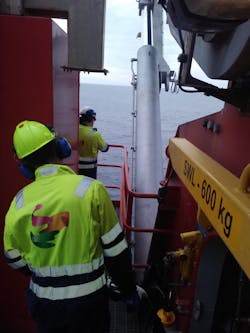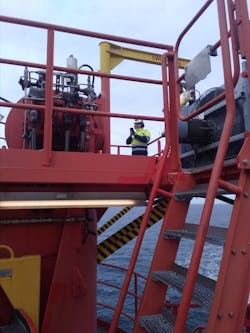Remote inspection methods improve efficiency, safety
Demand for digitally distanced surveys and inspections has escalated following the introduction of stringent global travel restrictions due to the COVID-19 pandemic, and unprecedented impacts on the oil price.
The provision of verification and certification services for topsides and subsea equipment is critical for essential components like risers, umbilicals, cables, lifting equipment, and workover systems.
Using digital tools, technology, and cloud platforms to transform this vital service, ‘virtual’ on-site inspections and surveys are proving to be quicker, more accessible, and cost-effective for all parties. However, it cannot be used to cover all inspection purposes and does not replace the knowledge and insight garnered from being physically onsite for regular and essential check-ups.
Same function, different application
Largely developed during the last downturn, remote inspection methods are based on convenient, low-cost, readily available live-feed technology such as smartphones, tablet computers, and digital cameras. Inspectors and surveyors located anywhere in the world can remotely ‘visit and verify’ quality and integrity to fully comply with company specifications or industry standards. Put simply, it is another means to perform an essential service more effectively in the long run by providing significant capex and opex benefits including:
• Reduced travel/accommodation costs
• Shorter response times
• Potentially quicker inspection and survey activities
• Greater scheduling flexibility
• Instant access to deep technical expertise
• Less operational downtime.
From its onshore bases, DNV GL has conducted more than 4,000 remote surveys in 2020. Examples include:
• Marine warranty survey and inspections of barge and platform in Senegal
• Recertification for offshore containers in Australia
• Material certification of subsea equipment in China
• Suitability survey for offshore operations in the Netherlands.
Working in partnership with companies across the supply chain the technical advisor has developed rigorous risk-based processes and guidance to ensure its use is trusted and compliant.
In the oil and gas industry remote technology is used by a broad range of industry players including Shell, BP, and Transocean.
For many companies who need third parties to carry out inspection and surveys regularly, remote technology has been implemented as the new alternative for many survey types. The DNV GL surveyor can watch the survey online and communicate with the owner’s representatives who are onsite with a camera or mobile. The company provides a standard tool for this purpose.
For larger companies with more integrated processes and systems it is beneficial to pilot the use of remote technology and inspections before this is fully or partly implemented. This gives the company peace of mind before a decision is taken related to the extent and type of inspection where this will be used in the future.
Virtual inspections on subsea equipment
Remote technology can be used across a variety of engineering, procurement, and construction operations. The approach is simple to use. With real-time or near-real-time access, it brings experts together in any internet-connected location, at any time, for quicker resolution of on-site issues.
Since 2018, DNV GL has worked closely with BP’s ACE project to promote the ease and advantages of virtual inspections on subsea equipment. Its potential to drive efficiency was fully understood and realized when the pandemic took hold in Italy and travel restrictions were enforced, and:
• Gives greater access to global network of experts
• Combined access to multi-service support
• Analytics of stored data can improve decision-making
• Use of stored digital data can be used for training and audits.
In this case, the company provided vendor surveillance and witnessing activities at vendor sites across the north of the country. Here, a local Italian DNV GL inspector worked from their home or office to direct vendor personnel to record or live-stream equipment or processes via a smart phone or tablet camera.
Tripods, stabilizers, or wearable technology can be used to improve the quality of the filming. High-definition images, video, and reports are then stored on military-grade servers to facilitate experts sharing insight and support critical decision-making.
While no specialist equipment is required, a specific, inspection-related application provides more functionality to accurately collate, analyze, and share data. Vendor training is also provided remotely. As in normal circumstances, the report or certification is issued upon completion.
Crane inspection, offshore Norway
In line with Aker BP’s strategy of minimizing its operational carbon footprint, DNV GL performed remote safety inspections of two knuckle boom cranes on Skarv, and one box boom pedestal crane on the Valhall Flank West, both as part of annual surveys.
Located in the southern Norwegian North Sea, the Valhall Flank West standalone wellhead platform is normally unmanned. Delivered in 2019, the box boom crane is electrically powered from shore via the Valhall field center, which not only reduces maintenance needs but also lowers carbon footprint by negating the need for diesel generators.
In normal circumstances, it would be a short helicopter flight for service and maintenance personnel to travel to the installation. However, in light of COVID-19 risk and travel restrictions, rather than send personnel back onshore after visiting installations, the inspection took place remotely.
For assets in hazardous or remote locations, the environmental and safety advantages of remote inspection are clear:
• Reduced risk in transporting personnel to site and accommodating visitors from the company and operator at site
• Removes the risk of delay where travel is not an option
• Reduced carbon footprint by removing the need to travel.
The one-year-old crane, manufactured by NOV, featured auto-testing of the automatic overload protection system function. It was the first time this was inspected by Aker BP along with the structural connections, critical hydraulic and electric components, the manual overload protection system, and brakes.
Crane operators and technicians on the platform used tablets to take close-up video and pictures of an agreed checklist of selected safety functions, which took little time to perform. Logs were sent to DNV GL and the rest of the safety functions were tested manually and reported. Communication and knowledge of the equipment or system in question is vital throughout the process between each party.
A similar inspection program has been performed on the Skarv field FPSO.
As Aker BP’s northernmost producing field, it boasts one of the worlds’ largest offshore gas processing plants. Anchored in 350-450 m (1,148-1,476 ft) of water and 210 km (130 mi) off the coast of Sandnessjøen, the ongoing assistance pilot task will fully assess how to perform key safety critical tasks remotely without jeopardizing trust and safety for personnel and the asset in the process. Avoiding return travel to Brønnøysund and helicopter travel to Skarv are a few examples of cost saving contributions of this approach.
Confidence and trust
Deploying and relying on digital technology to remotely perform the inspection and survey of safety critical equipment is relatively new and has been accelerated by the constraints placed by the pandemic.
The approach is efficient, straightforward, and intuitive to use. Crucially, it can allow the operator to participate in the activity from any location. In addition, technical issues can be discussed directly with the supplier to identify potential improvements to productivity and better support decision making or manage delay, without the additional impacts of concern for the wellbeing of personnel, operational carbon footprint, or increased costs associated with scheduling and travel. It can also cut waiting time.
A cost saving model has also highlighted that significant savings can be made with greater uptake of the approach and adoption throughout the supply chain.
Although some projects are at the pilot stage, more companies, depending on the type of projects, are now using remote inspection as a more accepted method and the ‘go to’ technology. It will be interesting to see if it will be fully considered as the equivalent of being physically onsite.
Certification bodies’ confidence in the process is also essential, not only to understand and overcome the limitations but to pinpoint and promote positive aspects and encourage wider improvement and application opportunities. As society adapts to new ways of working it will be interesting to see if its use beyond the pandemic becomes the new normal.
The author
Astri Haukerud was appointed Global Service Area Leader DNV GL’s Oil & Gas business area in May 2010. She has a Master of Science degree in Mechanical Engineering from the Norwegian Institute of Technology and joined the company in August 1991.
She has worked in several operational and governance roles within the organization, including Head of Section for offshore equipment and mooring, project management and CMC co-ordination of offshore class drilling units and FPSOs, certification of drilling equipment and mechanical components, analysis and verification of pipelines, risers and offshore structures.

